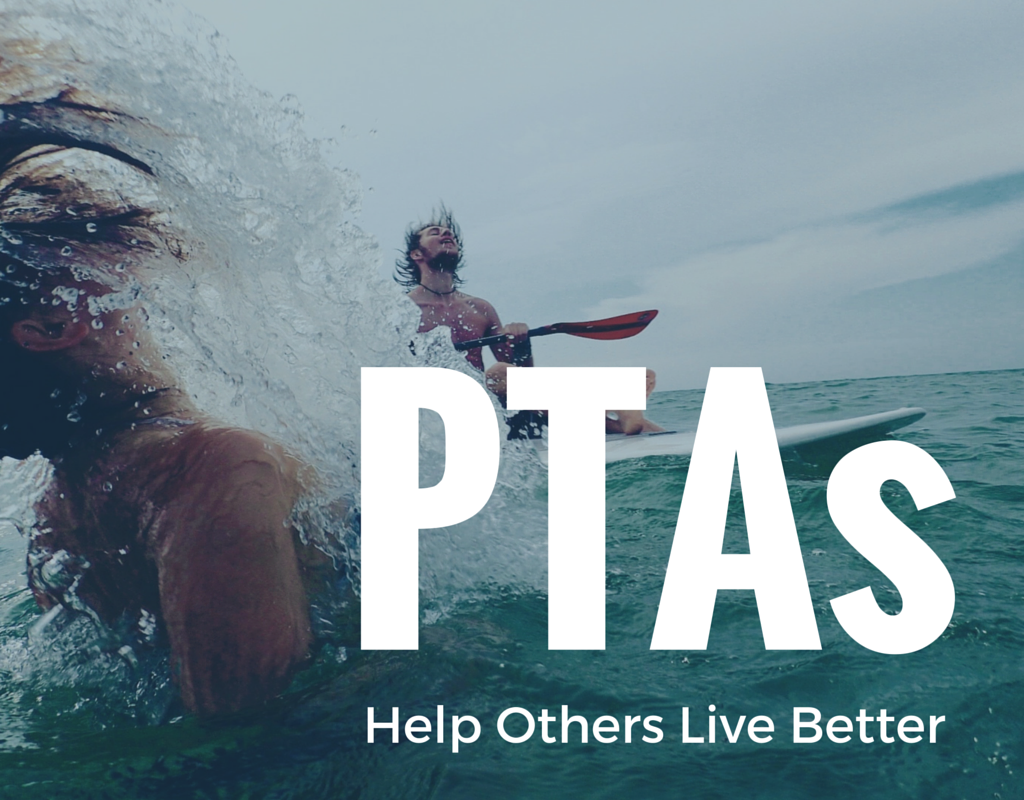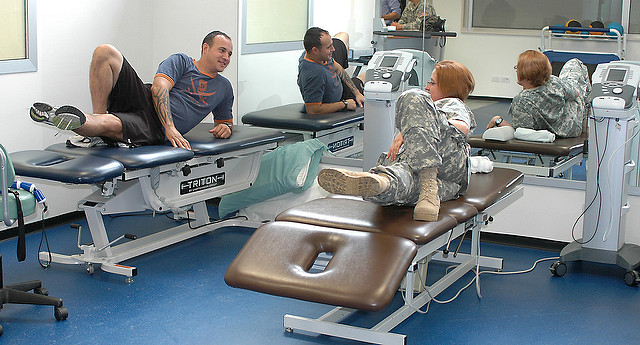MossRehab is so totally awesome that we are going to have to write a whole post dedicated just to them sometime.. but for now let’s just introduce how they use physical therapy to help others live better lives. Plus you are probably wondering what that surfing picture has to do with this article. 🙂
In a nutshell, MossRehab sends volunteer therapist, doctors, and nurses to a one day event to help those with spinal chord injuries into the ocean to surf again using special adaptive surfboards. Pretty sweet!
Here watch the video about the event: “They Will Surf Again”.
Helping people is awesome. If you agree and want a fulfilling career helping people then a PTA career could be for you. Whether you like working with kids, adults, or elderly – people of all ages need physical therapy. Stephanie Dyer is a PTA who really liked working with kids.
One of the highlights of Stephanie Dyer’s occupation was helping rehab firsthand as a 16 yr old girl recouped from a traumatic brain injury. With assistance from Dyer, a physical therapy assistant, and other medical experts, the high school girl came to almost a complete 100% recovery, and was even ready to return to school.
Dyer, 48, works for a wellbeing organization in Los Angeles, and she spends her days going to patients’ homes and working with them to perform different activities as well as walking and mobility; which is just the tip of the iceberg.
If this sounds like an awesome career to you, then keep reading. 🙂
The Role of a Physical Therapy Assistant
A PTA is prepared to help a physical therapist in the treatment and recovery process to the individuals who are physically injured, sick or incapacitated from an accident. The objective is to help individuals move with their regular motion again, walk better, decrease pain and empower patients to come back to their previous life they enjoyed – as much as possible.
All in all, a PTA may utilize manual treatment, therapy gadgets and/or some physical exercise or activity to carry out treatment with a patient. They often must make adjustments and add to a patient’s treatment plan in order to continue progress and achieve the best results. For example, tracking treatment progress and making adjustments to particular medicines or exercises.
PTAs help treat individuals of all ages – from pediatric to geriatric patients – with therapeutic or other wellbeing issues that impact their capacity to move and perform routine movements required for everyday living.
Related: What is a Physical Therapist Assistant?
PTA program director, Ed Greene at CBD College in Los Angeles, said PTAs have the option to choose from a wide variety of niches to work in. These include healing centers, restoration units, outpatient general PT facilities, outpatient orthopedic PT centers, sports PT facilities, nursing homes, home well-being offices, pediatric focuses and school exercise based recuperation programs.
While interest in, and knowledge of, science is required, every applicant should simaltaneously be somewhat of a “social butterfly” as great communication skills are required to perform the job. Ok, well you don’t necessarily have to be a social butterfly but you definitely should possess strong communication skills and be empathetic towards patients creating a good therapy experience for them.
A PTA career is one that requires spending time helping individuals helping them recover from injury, sickness, and trauma with the goal of getting back to as normal of a life as possible. Does that sound easy? Well, the career is extremely demanding. The knowledge required, and abilities used, to help individuals through their physical therapy treatment are many and sometimes technical.
Most physical therapist assistants appreciate and enjoy working with individuals and being alongside their patients while they recover from their injuries and sickness. Watching their work heal people gives them a sense of reward. They also appreciate practicing and instructing patients on the best way to carry on with a healthier and more content life, partly because it is inspirational to themselves to do the same.
PTA Education Requirements
To work in the field, prospects must acquire a two-year associates degree from a PTA program, Greene said. The calling’s accreditation body, the Commission on Accreditation in Physical Therapy Education (CAPTE), requires an 80-week program. Program requirements consist of general education classes in core subjects, for example, math, anatomy & physiology as well as biology, in addition to PTA classroom curriculum students will be required to gain experience with hands on clinical instruction.
Related: What Are Physical Therapy Assistant Requirements
All applicants must finish an entry level position, often called a clinical trial. This part of the program is typically required to last for about 16 to 18 weeks. Shortly after finishing their classroom requirements and their clinical trials, graduates must take a national licensure examination called the NPTAE. Licensure or accreditation is needed in many states to be licensed and legally work as a PTA.
Dyer got her degree at Loma Linda University in Loma Linda, CA. There, requirements are completed before the clinical trial starts, and the PTA program itself runs 16 months.
At CBD College, acceptance is highly competitive. A large number of qualified candidates compete for the school’s 64 spaces every year in the PTA program, Greene said. There’s a popularity for PTAs in the LA zone, he noted.
Free Resource: Search Local PTA Programs
PTAs will also have administrative duties at most positions on top of assisting patients with their treatment exercises. The industry appears to be moving to the point where once a physical therapist has assessed a patient and devised their therapy plan, the PTA can then administer most of the treatment, only assisted by the PT when necessary. The PTA will log notes on the patients progress and work with the PT to update the treatment plan as needed.
Greene said when comparing occupations on the grounds that the work helps enhance individuals’ lives, being a PTA is extremely rewarding.
“Physical Therapy Assisting is an awesome profession. It’s particularly involved in helping individuals with a hands-on approach to recovery and come back to their everyday lives,” he said.
PTA Jobs pay well and are in high demand
As indicated by the U.S. Department of Labor Statistics, PTA employments are anticipated to grow 41 percent by 2022. Interest in the career is anticipated to increase as the vast number of gen X-ers grow into starting their working careers.
As you can see in the chart below, by 2018 there are projected to be over 80,000 PT clinics.
Additionally, physical health conditions and disease that may require PT are increasing. For example, diabetes and obesity are expanding rather rapidly. This means that more physical therapists and PTAs will be required to help patients manage the impacts of such conditions.
In 2012, as per the BLS, there were 121,400 individuals working as PTAs. That same year, the middle yearly wage for physical therapist assistants was $58,790. The bottom 10 percent of PTAs earned about $32,420, while the top 10 percent took home close to $72,720.
If you enjoy helping others, consider a PTA Career
If helping others brings you a sense of reward then a PTA career would be great for you. Here are just a few ways that PTAs are helping their patients live better lives. On top of helping others, you will be compensated very well, especially considering the schooling requirements are only 2 years. A typical PTA salary falls somewhere between $32K – $72K depending on regionally where you land a job and in which therapy niche.
Get started with your PTA education today if you want a career that will make you feel rewarded as you help individuals heal and recover leading happier healthier lives:
Learn more about how to become a PTA or start searching local PTA programs now.
Are you a PTA? Or are you looking into a PTA career? If so, tell us about your experience in the comments below! 🙂



